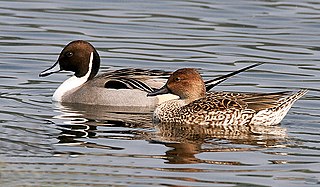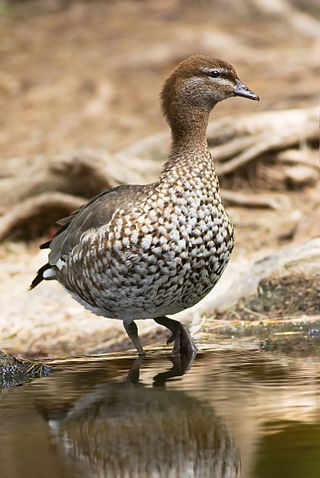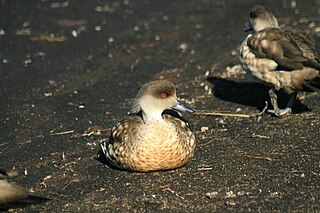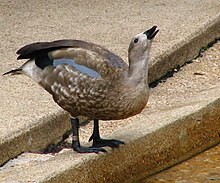
The Anatidae are the biological family of water birds that includes ducks, geese, and swans. The family has a cosmopolitan distribution, occurring on all the world's continents except Antarctica. These birds are adapted for swimming, floating on the water surface, and in some cases diving in at least shallow water. The family contains around 174 species in 43 genera.

The Anatinae are a subfamily of the family Anatidae. Its surviving members are the dabbling ducks, which feed mainly at the surface rather than by diving. The other members of the Anatinae are the extinct moa-nalo, a young but highly apomorphic lineage derived from the dabbling ducks.

The pintail or northern pintail is a duck species with wide geographic distribution that breeds in the northern areas of Europe and across the Palearctic and North America. It is migratory and winters south of its breeding range to the equator. Unusually for a bird with such a large range, it has no geographical subspecies if the possibly conspecific duck Eaton's pintail is considered to be a separate species.

The Tadorninae is the shelduck-sheldgoose subfamily of the Anatidae, the biological family that includes the ducks and most duck-like waterfowl such as the geese and swans.

The gadwall is a common and widespread dabbling duck in the family Anatidae.

The American teal or green-winged teal is a common and widespread duck that breeds in the northern areas of North America except on the Aleutian Islands. It was considered conspecific with the Eurasian teal for some time, but has since been split into its own species. The American Ornithological Society continues to debate this determination; however, nearly all other authorities consider it distinct based on behavioral, morphological, and molecular evidence. The scientific name is from Latin Anas, "duck" and carolinensis, "of Carolina".

The American black duck is a large dabbling duck in the family Anatidae. It was described by William Brewster in 1902. It is the heaviest species in the genus Anas, weighing 720–1,640 g (1.59–3.62 lb) on average and measuring 54–59 cm (21–23 in) in length with an 88–95 cm (35–37 in) wingspan. It somewhat resembles the female and eclipse male mallard in coloration, but has a darker plumage. The male and female are generally similar in appearance, but the male's bill is yellow while the female's is dull green with dark marks on the upper mandible. It is native to eastern North America. During the breeding season, it is usually found in coastal and freshwater wetlands from Saskatchewan to the Atlantic in Canada and the Great Lakes and the Adirondacks in the United States. It is a partially migratory species, mostly wintering in the east-central United States, especially in coastal areas.

The white-backed duck is a waterbird of the family Anatidae. It is distinct from all other ducks, but most closely related to the whistling ducks in the subfamily Dendrocygninae, though also showing some similarities to the stiff-tailed ducks in the subfamily Oxyurinae. It is the only member of the genus Thalassornis.

The knob-billed duck, or African comb duck, is a type of duck found along the tropical/sub-tropical wetlands and waterways of Sub-Saharan Africa and the island of Madagascar, as well as most of South Asia and mainland Indochina.

The comb duck or American comb duck, is an unusual duck, found in tropical wetlands in continental South America south to the Paraguay River region in eastern Paraguay, southeastern Brazil and extreme northeastern Argentina, and as a vagrant on Trinidad.

Aix is a bird genus that contains two species of ducks: the wood duck, and the Mandarin duck. Aix is an Ancient Greek word used by Aristotle to refer to an unknown diving bird.

The falcated duck or falcated teal is a gadwall-sized dabbling duck from the east Palearctic.

The Australian wood duck, maned duck or maned goose is a dabbling duck found throughout much of Australia. It is the only living species in the genus Chenonetta. Traditionally placed in the subfamily Anatinae, it might belong to the subfamily Tadorninae (shelducks); the ringed teal may be its closest living relative.

The spotted whistling duck is a member of the duck family Anatidae. It is also referred to as the "spotted tree duck". This duck can be found in Indonesia, New Guinea, Australia and the Philippines. Spotted ducks are also held in captive populations.

The Brazilian teal or Brazilian duck is the only duck in the genus Amazonetta. It is widely distributed in eastern South America.

The red-billed teal or red-billed duck is a dabbling duck which is an abundant resident breeder in southern and eastern Africa typically south of 10° S. This duck is not migratory, but will fly great distances to find suitable waters. It is highly gregarious outside the breeding season and forms large flocks.

Meller's duck is a species of the dabbling duck genus Anas. It is endemic to eastern Madagascar. Although a population was established on Mauritius in the mid-18th century, this is on the verge of extinction due to habitat loss and competition by feral domestic ducks. The species name of this species is after the botanist Charles James Meller, and its generic name is from the Latin for "duck".

The white-winged duck or white-winged wood duck is a large species of duck, formerly placed in the genus Cairina with the Muscovy duck and allied with the dabbling ducks. However, mtDNA cytochrome b and NADH dehydrogenase subunit 2 sequence analysis indicate that the anatomical similarity to the Muscovy duck is deceiving and that the species is appropriately placed in a monotypic genus, as Asarcornis scutulata, which is evolutionarily closer to the redhead.

Hartlaub's duck is a dark chestnut-coloured duck of African forests. Formerly included in the paraphyletic "perching duck" assemblage, it was later moved to the dabbling duck assemblage. However, it is fairly distinct from the "typical" dabbling ducks, and is placed in the monotypic genus Pteronetta to reflect this.

The crested duck or South American crested duck is a species of duck native to South America, belonging to the monotypic genus Lophonetta. It is sometimes included in Anas, but it belongs to a South American clade that diverged early in dabbling duck evolution. There are two subspecies: L. specularioides alticola and L. specularioides specularioides. The Patagonian crested duck is also called the southern crested duck and its range lies in the Falklands, Chile, and Argentina.


























